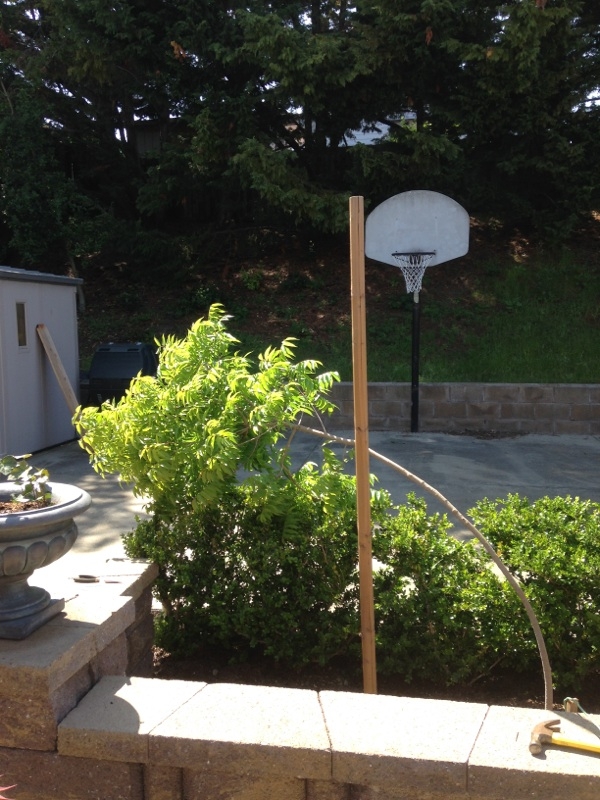Did you know that the Contra Costa Master Gardeners have a Help Desk where you can have your gardening-related questions answered? Well, we do! Our Help Desk is staffed every week, Monday-Thursday 9 a.m.-Noon. You can:
- Visit us during Help Desk hours at 75 Santa Barbara Road, 2nd Floor, Pleasant Hill, CA 94523.
- Call us at (925) 646-6586. If you call outside Help Desk hours, please leave both your phone number and email address so that we may respond to you in a timely manner.
- Email us at ccmg@ucanr.edu. Please use email if you want to submit photos along with your question(s).
As part of our effort to help educate the public, we are going to be sharing some of the interesting problems that other CoCo County gardeners have been having, and share the advice and solutions that our Help Desk volunteers have come up with.
Here is our first installment, on staking young trees for proper support.
The Client's Problem: Lazy Trees!
In September of 2011 the client bought three Pistacia chinesis trees. In September of 2012 the client planted the trees, but found that when the nursery stakes were removed each tree leaned over, almost to the ground. The client added two stakes to support the trees. In April of 2014, the client removed the stakes and found that two of the trees still leaned over about 45 degrees, and the third still fell almost to the ground (see pictures below).
So of course, the client's question is why is this happening? And what can be done to help the trees stand up straight and support themselves?
The Solution:
From the description and photos it looks like the trunks of your Pistache trees have not developed enough strength to stand on their own properly. There are a number of factors that can contribute to this condition. When you purchased the trees they were most likely staked in the pots with a single stake and closely tied to this stake, as a temporary measure. This was done by the nursery for ease in their operations and is not helpful to the tree long term.
Proper Staking
Staking of trees is undesirable in most situations and should only be used when absolutely necessary. When staking the trees it is important to use two stakes placed on either side perpendicular to the prevailing winds and not too close the tree (just outside the root ball zone). You will need to tie the tree to allow some movement of the trunk. Tree trunks develop their strength by bending and swaying in the wind very much as we develop strength through exercising our limbs.
For more information on staking, please refer to the following University of California website: http://ucce.ucdavis.edu/files/filelibrary/5253/16819.pdf
"Lollipop" Trees
Your trees also look a little top heavy which may contribute to their problem standing up in their weakened condition. Often nurseries sell container trees with large tops ("lollipop trees"). These trees have usually been "headed back" and have many branches arising from the same point. This is a sign of poor branch structure for the tree in the long term. Young trees should have branches along the length of the trunk as this provides food for the tree and shade protection for the young trunk. You can thin the canopy to help reduce the load but never remove more than one-third of the branches when doing so. Take care with pruning as some types of pruning can trigger the tree to grow many more branches, especially dormant pruning.
For more information on selecting and planting landscape trees please refer to the following University of California website: http://ucanr.edu/datastoreFiles/268-234.pdf
Girdled Roots
Another possible contributing factor to your trees not establishing themselves is their root structure. Often, when landscape trees are purchased from the nursery, they may have been growing in a small pot for an extended period of time and the roots have circled the trunk in the pot. This condition results in twisted and girdling roots which hampers the trees ability to take up nutrients and anchor itself in the ground.
Before resorting to digging up these trees, though, the client could make sure that the trees are properly staked, and continue to check on the trees' ability to stand upright every three months or so. However, in the end, the only solution to this client's problem might be starting over with new trees that were better pruned from the start, and were planted more quickly into the ground to prevent root girdling.
__________________________________________________________________________________
Editor's Note: Each month the CCMG Help Desk's Quality Assurance Team selects responses to county residents' Help Desk questions that produced informative responses that are either unique or unusual, or provided updated information that would be informative to all gardeners, or are of general interest, especially of seasonal concerns. We are highlighting these responses in the HortCOCO blog so all interested Master Gardeners and the public may utilize the information.
The CCMG Help Desk is available year-round to answer your gardening questions. Except for a few holidays, we're open every week, Monday through Thursday from 9:00 am to Noon at 75 Santa Barbara Road, 2d Floor, Pleasant Hill, CA 94523. We can also be reached via telephone: (925) 646-6586, email: ccmg@ucanr.edu, and we are on the web at http://ccmg.ucanr.edu/

